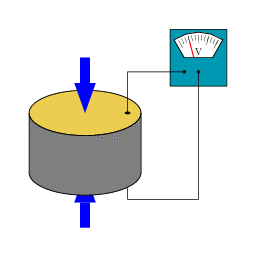Piezoelectric sensor facts for kids
A piezoelectric sensor is a clever device that can "feel" different things. It uses something called the piezoelectric effect to measure changes in pressure, how fast something is moving (acceleration), how hot or cold it is (temperature), or how much something is stretching or squeezing (strain). When these changes happen, the sensor turns them into a tiny electrical signal. The word piezo- comes from Greek and means 'press' or 'squeeze'.
Contents
What are they used for?
Piezoelectric sensors are very useful tools that can measure many different things. They help make sure products are good quality and keep machines working well in factories. Scientists also use them to invent new things.
A scientist named Pierre Curie first discovered the piezoelectric effect in 1880. But it wasn't until the 1950s that companies started using these sensors in their products. Since then, this way of measuring has become very popular and reliable.
Everyday uses
These sensors are used in many places, like in hospitals, airplanes, and even in nuclear power plants. You might find them in your mobile phone's touch screen or as a sensor that tells if your phone is tilted.
In cars, piezoelectric parts help engineers check how car engines are burning fuel. The sensors can be put right into the engine's cylinder head. Sometimes, they are even built into the spark plugs or glow plugs.
What are they made of?
Piezoelectric sensors are made from three main types of materials. These are special ceramics, natural crystals, and very thin film materials.
Ceramic materials
Ceramic materials, like PZT ceramic, are very sensitive. They can create a much bigger electrical signal than natural crystals. These ceramics are also cheaper to make using a process called sintering. However, their high sensitivity can slowly decrease over time, especially if they get too hot.
Crystal materials
Natural crystal materials, such as gallium phosphate, quartz, and tourmaline, are not as sensitive as ceramics. But they are very stable and can last a very long time if they are handled carefully.
There are also newer types of crystals available, like Lead Magnesium Niobate-Lead Titanate (PMN-PT). These crystals are more sensitive than PZT ceramics. But they cannot handle very high temperatures and are harder to make.
Thin film materials
Thin film piezoelectric materials are made using special methods like sputtering or CVD (Chemical vapour deposition). These materials are used when measurements need to be taken at very high speeds (over 100 MHz). They are also great for applications where the sensor needs to be very small.
Images for kids
See also
 In Spanish: Sensor piezoeléctrico para niños
In Spanish: Sensor piezoeléctrico para niños



